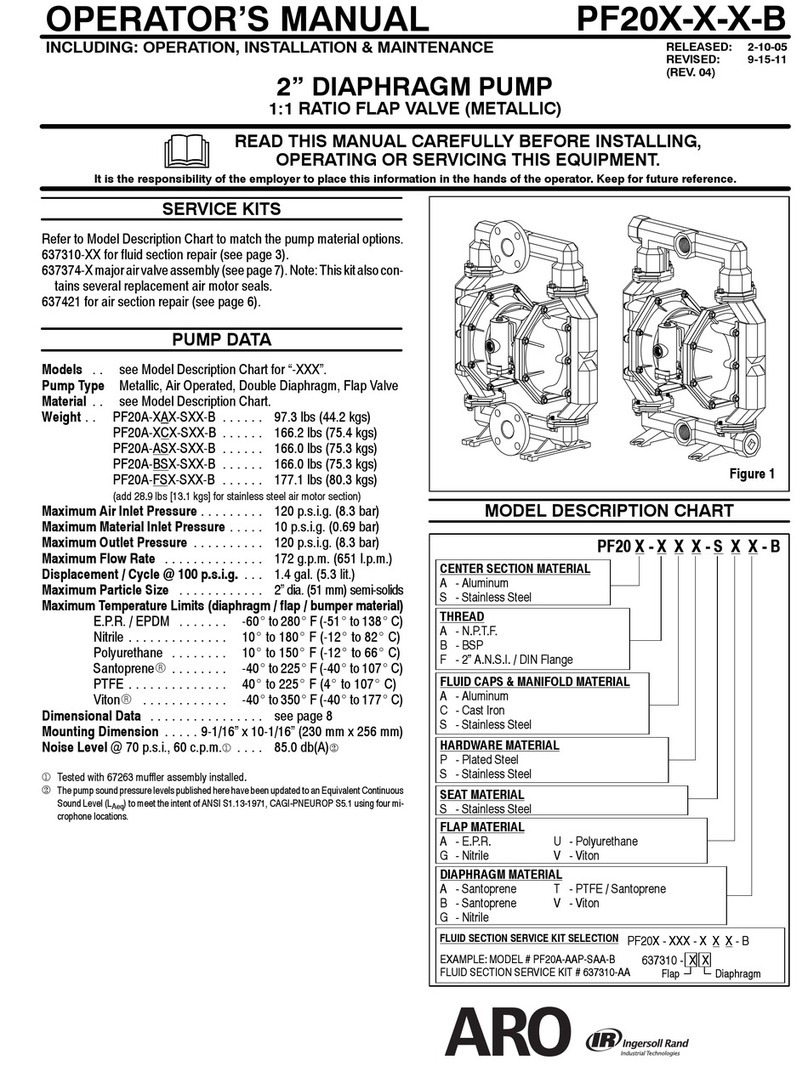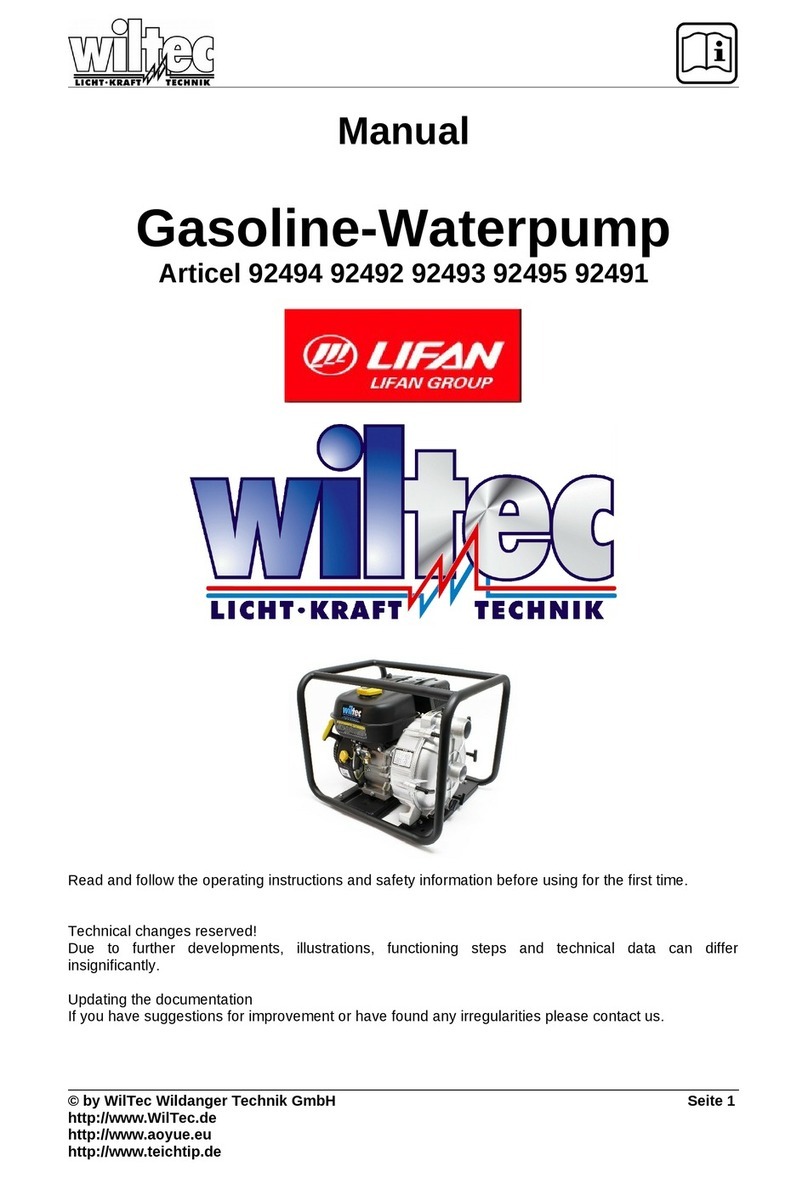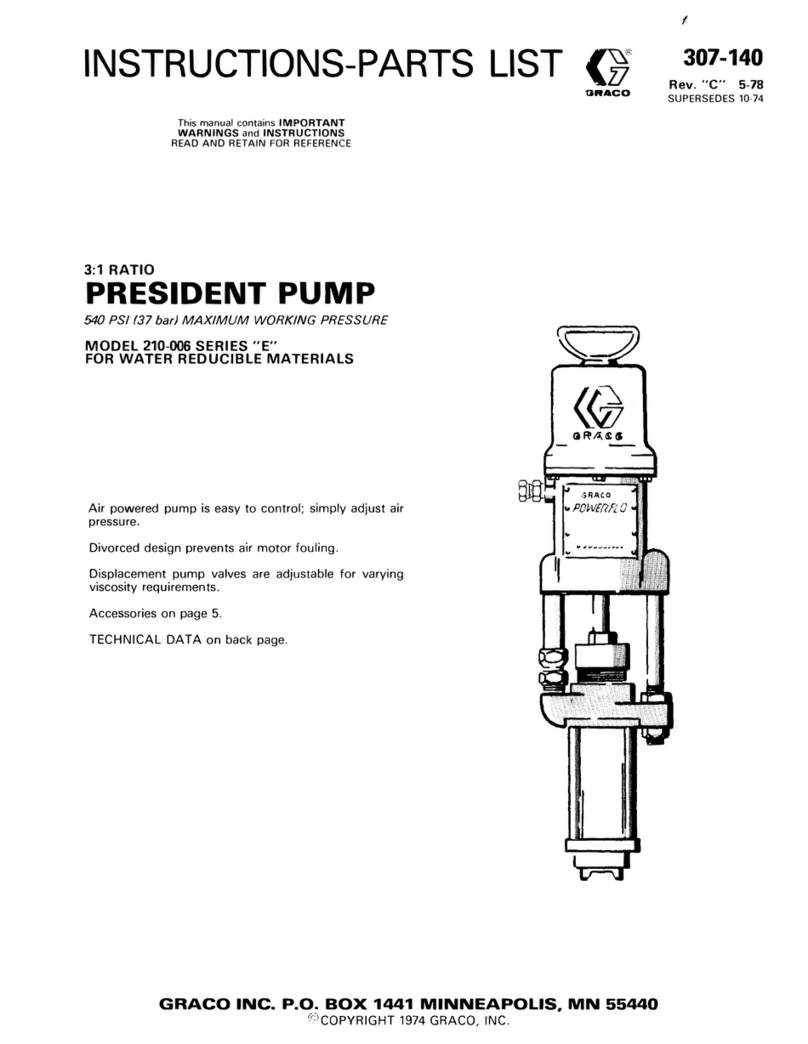Industrial Flow Solutions Stancor S Series User manual

_____________________________________________________________________________________________________________________
EI-700-001 Rev --
Installation,
Operation
and Maintenance
Manual
Stancor™
S & P Series
Dewatering Pumps

2
Table of Contents
Safety Guidelines: 3
Description: 4
Versions: 4
Capacity: 4
Motor Protection: 4
Power Supply Cable*: 4
Application: 4
Temperature of Water: 4
Depth of submersion: 4
Material Specifications: 4
Principle of Operation: 4
Handling: 4
Location: 4
In Cold Weather: 4
Cleaning: 5
Storage: 5
Accessories: 5
Operation: 5
Electrical Connections: 5
How to Change Voltage Connections: 5
Before starting: 6
Checking Direction of Motor Rotation: 6
Pump installation: 6
Care and Maintenance: 7
Inspection: 7
Service contract: 7
Troubleshooting: 8
General Check: 8
Seal Housing Oil: 8
Inspection of Seals: 8
Check of Insulation, Motor Resistance: 9
Bearing Lubrication: 9
Inspection of Wear Parts–Adjusting: 9
Power Supply Cable Replacement: 10
Wear parts replacement high volume: 11
Two piece diffuser and wear plate: 11
One piece diffuser and wear plate: 11
Wear Parts Replacement High Head: 12
Single impeller versions: 12
Two Impeller Versions: 12
Appendices: 15
List of Parts: 15
Exploded Views/Cross Section Drawings: 15
Wiring Diagrams: 15
Appendices: 16
Technical Data: 16
Specifications: 16
Notes 17

3
Safety Guidelines:
This instruction manual provides you with the
information required to safely own and operate your
product.
Retain these instructions for future reference.
The product you have purchased is of the highest
quality workmanship and material and has been
engineered to give you long and reliable service.
This product has been carefully tested, inspected, and
packaged to ensure safe delivery and operation.
Please examine your item(s) carefully to ensure that
no damage occurred during shipment.
If damage has occurred, please contact the place of
purchase. They will assist you in replacement or
repair, if required.
READ THESE INSTRUCTIONS CAREFULLY
BEFORE ATTEMPTING TO INSTALL, OPERATE,
OR SERVICE YOUR PRODUCT.
KNOW THE PRODUCT’S APPLICATION,
LIMITATIONS, AND POTENTIAL HAZARDS.
PROTECT YOUR-SELF AND OTHERS BY
OBSERVING ALL SAFETY INFORMATION.
FAILURE TO COMPLY WITH THESE
INSTRUCTIONS COULD RESULT IN PERSONAL
INJURY AND/OR PROPERTY DAMAGE!
WARNING: RISK OF ELECTRIC SHOCK.
To reduce the risk of electric shock, be certain that the
pump is connected only to a properly grounding type
circuit.
When a pump is in a basin, do not touch motor, pipes
or water until the power supply is disconnected.
If your installation has water or moisture present, do
not touch wet area until all power has been turned off.
Failure to follow this warning can result in fatal
electrical shock.
The flexible jacketed cord assembly mounted to the
pump must not be modified in any way, with the
exception of shortening the cord to fit into a control
panel.
Any splice between the pump and the control panel
must be made within a junction box and mounted
outside of the basin, and comply with the National
Electrical Code.
Do not use the power cord for lifting the pump.
The equipment grounding lead is the conductor with a
green or green with yellow stripes insulation.
Read all instructions and Safety Guidelines thoroughly.
Failure to follow the guidelines and instructions could
result in serious bodily injury and/or property damage.
DO NOT USE TO PUMP FLAMMABLE OR
EXPLOSIVE FLUIDS SUCH AS GASOLINE, FUEL
OIL, KEROSENE, ETC.
FAILURE TO FOLLOW THIS WARNING CAN
RESULT IN PERSONAL INJURY, DEATH AND/OR
PROPERTY DAMAGE.
During normal operation, this pump is immersed in
water. Also, during rainstorms, water may be
present in the surrounding area of the pump.
Caution must be used to prevent bodily injury when
working near the pump. Electrical power should be
disconnected prior to touching, servicing or repairing
the pump.
Do not run the pump in a dry basin. If the pump is
run in a dry basin, the surface temperature of the
pump will rise to a high level. This high temperature
could cause skin burns if the pump is touched and
will cause serious damage to your pump.

4
Description:
The “P”, “S” and “SX” series are submersible electric,
centrifugal pumps. They are manufactured to be
rugged, portable, and easily moved by two men or a
small truck crane. The seal housing contains
lubrication oil for the mechanical seals.
These pumps can operate with the motor housing
partially exposed for limited periods of time, providing
sufficient motor cooling and seal lubrication. However,
for the best cooling and longest motor life, the liquid
level being pumped should normally be above the top
of the motor housing.
Versions:
This line of pumps are manufactured for use as a
standard dewatering pump or as an “MSHA Approved”
explosion proof dewatering type for use in gassy mines
as approved by MSHA.
Capacity:
All models are available in two executions, High
Volume (HV) or High Head (HH). By converting a
pump from HV to HH execution (or vice versa) the
pump can be used within a broader field of head and
flow conditions.
Motor Protection:
The pump has a built-in contactor with overload relay.
Furthermore, there are two thermal protection contacts
in the stator windings. The thermal protection contacts
open at 130°C (265°F) and the motor stops.
A Stancor control box, or approved equal must be
used to support warranty claims.
Power Supply Cable*:
Stancor uses CSA, UL, and MSHA approved
submersible cable as standard on all models.
Standard length is 50 feet, custom lengths and gauges
are available. When replacing pump cable always use
Stancor approved cable to ensure the integrity of the
sealing gland.
*MSHA Approved Pumps must use MSHA
Approved cable!
Application:
Clear or abrasive laden water.
Temperature of Water:
Temperature of water pumped should not exceed
104°F (+ 40°C).
Depth of submersion:
The operating depth should not exceed 82 feet (25
meters). In certain cases, however, the pump may
be able to work at greater submersion depths,
please contact the factory for special directions.
Material Specifications:
Motor housing and top cover are made of aluminum.
Discharge connection, impellers strainer, shaft and
all external hardware is stainless steel. Wearing
parts are made of especially wear resistant synthetic
rubber. Other materials of construction may be
available for special applications, please consult
factory.
Other materials of construction may be available for
special applications, please consult factory.
Principle of Operation:
The impeller draws water through the strainer. The
vanes of the impeller impart energy to the water
forcing it through the diffuser and along the wall of
the motor housing to the outlet at the discharge hose
connection. The motor is effectively cooled by the
water flow.
Handling:
Lift the pump by its handle.
Never by the motor cable, severe personal injury
may occur as well as damage to the pump
assembly.
Location:
Make sure that the pump is not digging itself
into sand or clay. Place the pump on a firm base
or suspend it by the handle in some way above
the bottom of the pit, ditch etc. Such a location
will prevent unnecessary wear on the wear
parts.
In Cold Weather:
The pump will not freeze as long as it is running
or is fully submerged in water. If the pump is
taken out of water and is stored at low
temperature the impeller may freeze. Therefore,
keep the pump submerged in water and let it
thaw before it is started up again. Never use a
blow torch for thawing because the rubber
coated parts and the 0-rings inside the pump
may become damaged.

5
Cleaning:
Thoroughly flush the pump with clear water if it
has been pumping clay, cement, or abrasive laden
water. The contaminants may solidify and lock the
impeller or block the flow passages, with a
resultant loss of performance.
Storage:
After flushing and draining, store the pump in a
dry place if the pump is not to be run for long
periods of time.
Accessories:
If one pump is not sufficient for reaching the head
required or the water flow volume desired, several
pumps can be connected in series or parallel
connected.
Series Connection of Pumps
By connecting the discharge on one pump to the inlet
of another pump by means of an accessory adaptor,
the pumps can be series "staged". Two or more pumps
can be used in this manner. The volume output will be
equivalent to one pump, but their combined head will
be the sum of the heads of the total number of pumps
used.
Parallel Connection Pumps
When pumps are parallel connected, two or several
pumps are connected to a common discharge pipe.
Between each pump and the common discharge pipe
there is a non-return valve that can be shut off. The
water flow volumes of each of the pumps will be added
together, but the maximum head will equal that of a
single pump.
HH/HV Conversion Kit
A conversion kit to change a high-volume pump to a
high head pump (high head kit) or vice versa (high
volume kit) is available. The kit comprises impeller,
impeller disc and diffusor(s) as well as necessary
mounting parts. Parts and quantities are specified in
the spare parts list (compare designations HV and HH)
Protection against corrosion/erosion
The pumps can be equipped with zinc anodes to
prevent galvanic corrosion when used in brackish or
salt water. The protection adds considerably to the
life of the pump in corrosive surroundings but is not
permanent and regular maintenance is therefore
necessary. The zinc anodes are fastened with bolts
onto the strainer of the pump and can be fitted to all
pump models.
Hard coat/Teflon®is also available for applications
that require an abrasive resistant finish. Consult
factory for specific applications.
Operation:
Check that the power is off and line
disconnected before working on pump.
Electrical Connections:
Check that the line voltage corresponds to the rated
voltage marked on the data plate of the pump.
The pump can be supplied with various motors
either for 230, 460, 575 or 950 volts 60 Hz.
Other voltages and Hz can/may be supplied by
special request. Contact an authorized
distributor or Stancor for assistance.
Always have the pump serial number
available.
How to Change Voltage Connections:
Stancor uses motors wound for a specific single
voltage only.
No changes can be made to the motor winding
leads to connect to an alternate voltage.
When a pump motor connected for 460 volts is
going to be used for 230 volts, the stator must be
changed and the overload relay (item 92) must be
replaced. Contact an authorized repair facility or
Stancor for assistance.
Certain custom applications may have dual
voltage motors, consult factory for assistance.

6
Before starting:
Check that the oil is clean and at the specified level.
Remove the fuses or open the circuit breaker and
check that the impeller can be rotated by hand.
Check that the monitoring equipment (if any) works.
Check the direction of rotation. See Checking Direction
of Motor Rotation (Figure 1).
All electrical work shall be carried out under the
supervision of an authorized electrician.
Local codes and regulations shall be complied with.
Check that the supply voltage and frequency agree
with the specifications of the pump data plate.
Under no circumstances may the starter
equipment be installed in the pump pit.
Install the motor cable and the control cable as
illustrated in the wiring diagrams.
Make sure that the fuses or circuit breakers are of the
properly sized for the pump amperage.
The starting surge with the direct-on line start can
be up to six times higher than the rated current.
Fuse amperage / circuit breaker settings and cable
shall be selected in accordance with local rules and
regulations.
With long cables, the voltage drop in the cable
must be taken into consideration, since the
motor's rated voltage is the voltage that is
measured at the terminal board in the pump.
The overload protection (motor protection breaker)
shall be set to the motor's rated current as given on
the data plate.
Checking Direction of Motor Rotation:
Suspend, tilt or lay down the pump and start it.
When it starts a heavy kick should be felt and seen
in a counterclockwise direction (direction of arrow
cast into the pump top cover) if the motor is correctly
connected. See figure 1.
If the kick appears in the opposite direction,
clockwise, reconnect by switching two of the power
cable leads in the control box (three phase only).
Check that the power is off before working on
the pump. Check the direction of motor rotation
after every new connection is made, after a phase
failure or a motor replacement.
If the motor rotates in the wrong direction, the
pumping capacity is decreased, and the motor
will be overloaded due to impeller flow
dynamics.
It is very difficult to determine the direction of
rotation by watching the discharge flow of water
or through pump amp draw readings!
Pump installation:
Run the cables so that they do not have any sharp
bends and are not pinched.
Connect the discharge connection and motor cable.
See "Electrical connection".
Check for proper rotation
Lower the pump into the sump.
Place the pump on a base which will prevent it from
sinking into a soft sump bottom.
Alternatively, the pump can be suspended by its
handle just above the sump bottom.
Figure 1- Start Rotation

7
Care and Maintenance:
Before starting work on the pump, make sure that
the pump is isolated from the power supply and
cannot be energized.
Inspection:
Regular inspection and preventive maintenance
ensure a more reliable operation. The pump should be
inspected after 2,000 hours of operation, more
frequently under severe operating conditions.
Under normal operating conditions, the pump should
have a major overhaul in a service shop at least once
a year.
This requires special tools and should be done by an
authorized service facility.
When the pump is new or when the seals have been
replaced, inspection is recommended after one
week of operation.
Service contract:
Stancor or its agents may offer service agreements
in accordance with a preventive maintenance plan.
For further information, please contact your Stancor
representative.
Regular Inspection: Weekly Monthly Bi-monthly
Semi-
annually Annually
Measure insulation resistance.
Reference insulation resistance = 1MΩ or greater.1
●
Measure operating current.
Compare with rated current ●
Measure supply voltage.
Compare with allowable range (within ±5% of
rated voltage).
●
Pump inspection.
A noticeable drop in performance may indicate wear
in the impeller, etc., or clogging of the strainer, etc.
Remove the clogged debris and replace any worn
parts.
●
Seal inspection.
Check the seal every 2 months or every month
depending on liquid pumped.
●●
Oil inspection.
Check the oil every six months or after 2,000 hours
of use, whichever comes first.
●
Change oil.
Change the oil every 12 months or after 4,000 hours
of use, whichever comes first.
●
Change mechanical seal.
3
●
Overhaul.
This should be carried out even if there are no
problems with the pump.
The frequency depends on how continuously the
pump is in use.
4
●
1 If the insulation resistance has become noticeably lower than the previous inspection, an inspection of the motor will be necessary
2 See Lubricant Inspection and Lub
ricant Change in this section
3
Specialized know-how is required for inspecting and replacing the mechanical seal. Consult with your nearest dealer or Stancor representative
4 Consult with your nearest dealer or Stancor representative regarding overhauls.

8
Troubleshooting:
General Check:
Pump won't start
Cause may be:
Power failure (zero-line voltage) or incorrect line
voltage
Blown fuse or circuit breaker
Damaged power supply cable
Blocked impeller, turn off power, disconnect pump,
check that the impeller is free to turn by hand
Phase failure
Poor performance not pumping full capacity or
head.
Cause may be:
Choked discharge hoses or water passages.
Worn impeller (15), impeller disc (12) or diffusor (19).
Discharge hose damaged, kinked or too long.
Impeller rotates in wrong direction.
If water in top cover (electric chamber)
Cause may be:
Cable rubber sheathing is damaged, so water leaks in
between the cores.
Cable entry (6) not tight enough, or the underlying
grommet (24) damaged.
Damaged 0-rings or seal faces between top cover (4)
and motor housing (3) or between top cover and
connection cover (10).
If water or oil in motor housing
Cause may be:
Damaged seals (67) and (112) inspect the seals and
replace them with new ones if necessary.
Damaged o-rings or seal faces between top cover (4)
and motor housing (3) or between connection cover
(10) and top cover.
If water or oil is found in the motor housing the pump
has to be disassembled for overhaul.
Water in oil housing
Cause may be:
Damaged seals (67) and (112) inspect the seals and
replace them with new ones if necessary.
Damaged 0-rings between motor housing (3) and oil
housing cover (16), motor housing and top cover (4),
or between connection cover (10) and top cover.
Damaged Dubo-rings (55) or "oil" inspection screws
not tightened.
Have a qualified pump-mechanic correct any faults or
please contact your representative's service center for
prompt pump service.
Routine Overhaul:
Seal Housing Oil:
If the pump or the pump shaft seals are new the
seals should be inspected after two weeks of
continuous operation.
Then check the seals every second month if the
pump has been working in relatively clean water.
If the water is severely contaminated and contains
abrasive particles the seals should be inspected
once every month. Inspection of seals should be
done in conjunction with re-placement or adjustment
of impeller and diffuser, see Inspection of Seals.
Inspection of Seals:
Lay the pump horizontally, with the two oil
inspection/fill ports facing the 12:00 o’ clock and
10:00 or 2:00 o’clock position. Remove the screws
(76) and dubo rings (55). Turn the pump so that one
of the "Oil" holes will allow some oil to drain and
collect it in a vessel. If the oil is clean and free from
moisture or contaminants the seals are intact.
If the color of the oil is light yellow-grey and slow-
flowing (like a milkshake) or if there is a noticeable
trace of water, the seals should be inspected, and
the oil replaced. Check then the oil again within an
operation period of two weeks.
Use oil in accordance with the recommendation
below.
Check that the Dubo-rings (55) on the "Oil" screws
are not damaged. Tighten the "Oil" screws firmly.
The oil compartment should be filled with 4 pints (2.3
liters) freeze-proof motor oil SAE 10w-30.
The following oils are recommended:
Citgo Superguard SAE-10W-30 or equal.
If the pump is going to be used for fluids which must
not become contaminated, for example for pumping
drinking water — use a tasteless and odorless oil
such as MOBIL Oil Whiterex 332.
THE NYLON DUBO SEALS ARE A ONE TIME
USE PARTS AND MUST BE REPLACED EVERY
SINGLE TIMES THE SCREWS ARE
UNTIGHTENED OR THEY WILL NOT SEAL
PROPERLY.

9
Check of Insulation, Motor Resistance:
In conjunction with an overhaul, the insulation
resistance of the stator windings should be checked.
Remove connection cover (10) and disconnect stator
leads from the contactor assembly and terminal.
When testing with a 500 volts D.C. "megger" the
resistance should exceed 1 Meg Ohm between each
of the phases and the phases to the motor housing as
well as between the phases and the thermal protection
contacts.
When the resistance of the windings is measured, the
resistance should be equal in all windings.
Do not “megger” through the thermal sensors
leads.
The following resistance values are valid at a
temperature of +68°F (+ 20°C) for stator
assemblies.
Pump
Model
Voltage
230V
460V
575V
950V
S150
P20CE
8.80 17.51 26.53 N/A
S500
P30CE
1.29 3.87 6.42 N/A
S750
P40CE
1.10 2.20 N/A
S1000
SX1000
1.20 2.00 N/A
S1500
P60CEM
0.50 0.78 1.23 3.90
S2000
SX2000
0.14 0.56 0.81 3.21
S3000
P70CE
0.09 0.30 0.50 0.44
S4500
SX4500
N/A 0.22 0.37 1.12
S6000-2P
SX6000-2P
N/A 0.10 0.12
S6000-4P
SX6000-4P
N/A 0.20
S7500
SX7500
N/A
Bearing Lubrication:
Upper Bearings
All pump models’ upper bearings are sealed
bearings and do not require maintenance.
Lower Bearings
All pump models except S4500 (SX4500), S6000
(SX6000) and S7500 (SX7500) lower bearings are
sealed bearings and do not require maintenance.
Stancor Model S4500 (SX4500), S6000 (SX6000)
and S7500 (SX7500) use two angular contact ball
bearings.
These must be packed 2/3 full of grease
(Chevron SRI-NLGI 2) or equivalent prior to
installation, no further maintenance is
required. See ball bearing replacement for
more details
Inspection of Wear Parts–Adjusting:
Check that impeller (15), diffuser (19) and impeller
disc (109) (for HH models) are not worn out.
Relatively generous wear of the impeller vanes
and the rubber coating of the diffuser can be
allowed, but this will of course result in decreased
pump capacity.
HV & HH configuration: If the lip area of the seal
housing is damaged or if the face of the seal
housing has been worn more than 1/16" (1.5 mm)
at the periphery, the seal housing should be
replaced with a new one.
By adjusting at regular intervals, the life of
impeller and diffuser will be considerably
increased. This is due to the fact that these parts
will wear relatively quickly when the clearance
between impeller and diffuser is large — a small
clearance (well-adjusted pump) means that these
wear parts will last a considerably longer period of
time as they are operating with higher efficiency.
Adjustment of the diffuser can be carried out by
tightening nuts (53), crosswise gradually, at the
lower side of the diffuser in such a way that the
impeller lightly touches the diffuser. The diffuser is
locked by tightening inner nut (53) against outer
nut (53) by means of using two 19 mm wrenches.
In order not to change the position of the diffuser,
hold the inner nut in a firm grip when the outer
one is tightened. Check that impeller can be
easily rotated by hand. When replacing a worn-
out impeller the impeller disc should also be
replaced with a new one, see also Wear Parts
Replacement (High Volume or High Head).

10
Power Supply Cable Replacement:
If the cable has been damaged it must immediately be
replaced. The cable is reconnected in the following
way: Loosen and remove screws (52) and remove
cable clamp (7). Remove screws (154) Remove
screws (45) and lift off connection cover (l0). Pull out
the cable from connection cover and cable entry (6).
Check that rubber bushing (24), washers, (101/78) and
cable clamp (7) are undamaged.
Split the outer sheathing of the cable so that the length
of the yellow (MSHA ground check), and green ground
leads are 8" and the length of the other leads is 5". Put
the cable entry (6), washer (101), rubber bushing (24),
washer (78) and connection cover (10) on to the cable.
Connect the ground leads (green) to ground
connection (51) inside the pump top and the yellow
(MSHA ground check) to its respective location. The
power leads should be connected to their connections
on the contactor (see wiring diagram).
Tighten all connections firmly.
Coat O-rings (30) on connection cover (10) with
Vaseline or silicone assembly lubricant. Mount
connection cover using the three hex bolts (45) and
lockwashers (94), being careful to orient the cover
so the two cast bosses line up with the
indentations in the top cover and the bolt holes are
in alignment. Then push the cable as far as possible
down through the connection cover to full stop at the
contactor mounting plate. Then slide washer (78),
rubber bushing (24) and washer (101) along cable into
socket for bushing. Slide cable entry (6) against the
washer and hold firmly while pulling cable back
approx. 1-1/2”.
*Tighten screws (154), so that the flange of the cable
entry (6) is within ⅛” to ¼” of the connection cover.
Mount cable clamp (7) and firmly tighten it with screws
(52). Check that the cable clamp is in contact with the
cable entry.
*MSHA PUMPS REQUIRE SAFETY LOCKWIRE (79)
BETWEEN BOLTS (152) (52), AND THE ⅛” TO ¼”
TOLERANCE BE MAINTAINED BETWEEN (6) (10).
Mount cable clamp (7) and firmly tighten it with screws
(52). Check that the cable clamp is in contact with the
cable entry.

11
Wear parts replacement high volume:
Two piece diffuser and wear plate:
Disassembly:
Place the pump on a bench with the strainer outward.
Loosen nuts (23) holding strainer (14). Pull off strainer
and remove washers (108) as well as spacers (107).
Loosen nuts (53) holding diffuser (19). Use two 19 mm
wrenches and hold the inner nuts in a firm grip while
the outer ones are loosened. See pic #4.
Remove the diffuser. With the diffuser on a work bench
remove the three nyloc nuts (23) and washers (54)
securing the diffuser inlet (154) to the diffuser (19)
evenly pry out diffuser inlet and inspect for wear,
replace if worn, remove the three studs (42) securing
inlet, and save to install on new diffuser (19). Remove
impeller (15) by loosening the impeller nut (77) and
removing washers (71) and sleeve (83). Inspect shaft
for burrs and clean. Apply a light coat of oil to the shaft
and gently slide the impeller off the shaft, being careful
to save the key (164). Remove the shim (167).
Assembly:
With the pump lying horizontally on the bench, inspect
the shaft for any burrs and the keyway is clear of any
debris, clean and dress as necessary. Place a light
coating of oil on the shaft. Install shim (167) to allow
clearance behind the impeller so as not to hit oil
housing cover (16). Install key (164), slide the impeller
(15) on the shaft, being careful to align with the key.
Install spacer (83), washers (71), and impeller nut (77).
Tighten securely while holding the impeller with
suitable tool. Fit the diffuser inlet (154) to the diffuser
(19) using the three studs (42) washers (54) and Nyloc
nuts (23). Mount new diffuser (19) on studs (41). Put
on washers (54) and nuts (53) and tighten them evenly
until the impeller vanes will be located about .039" (1
mm) from the diffuser. Adjust the position of the
diffuser accurately by cautiously tightening the inner
nuts so that the impeller vanes will smoothly and lightly
touch the full surface of the diffuser. Tighten outer nuts
(53) (use the two 19 mm wrenches) while securing the
inner nut (53) in a firm grip so that the position of the
diffuser will not be changed. Check that the impeller
can be rotated by hand. Reinstall spacers and strainer.
One-piece diffuser and wear plate:
Disassembly:
Place the pump on a bench with the strainer
outward. Loosen nuts (23) holding strainer (14). Pull
off strainer and remove washers (108) as well as
spacers (107). Loosen nuts (53) holding diffuser
(19). Use two 19 mm wrenches and hold the inner
nuts in a firm grip while the outer ones are loosened.
See pic #4.
Remove the diffuser.Remove impeller (15) by
loosening the impeller nut (77) and removing
washers (71) and sleeve (83). Inspect shaft for burrs
and clean. Apply a light coat of oil to the shaft and
gently slide the impeller off the shaft, being careful to
save the key (164). Remove the shim (167).
Assembly:
With the pump lying horizontally on the bench,
inspect the shaft for any burrs and the keyway is
clear of any debris, clean and dress as necessary.
Place a light coating of oil on the shaft. Install shim
(167) to allow clearance behind the impeller so as
not to hit oil housing cover (16). Install key (164),
slide the impeller (15) on the shaft, being careful to
align with the key. Install spacer (83), washers (71),
and impeller nut (77). Tighten securely while holding
the impeller with suitable tool. Mount new diffuser
(19) on studs (41). Put on washers (54) and nuts
(53) and tighten them evenly until the impeller vanes
will be located about .039" (1 mm) from the diffuser.
Adjust the position of the diffuser accurately by
cautiously tightening the inner nuts so that the
impeller vanes will smoothly and lightly touch the full
surface of the diffuser. Tighten outer nuts (53) (use
the two 19 mm wrenches) while securing the inner
nut (53) in a firm grip so that the position of the
diffuser will not be changed. Check that the impeller
can be rotated by hand. Reinstall spacers and
strainer.

12
Wear Parts Replacement High Head:
Single impeller versions:
Disassembly:
Place the pump on a bench with the strainer outward.
Loosen nuts (23) holding strainer (14). Pull off strainer
and remove washers (108) as well as spacers (107).
Loosen nuts (53) holding diffuser (19). Use two 19 mm
wrenches and hold the inner nuts in a firm grip while
the outer ones are loosened. See pic #4.
Remove the diffuser. Remove impeller (115) by
loosening the impeller nut (77) and removing washers
(71) remove the impeller spacer (83) from the shaft.
Inspect shaft for burrs and clean. Apply a light coat of
oil to the shaft and gently slide the impeller off the
shaft, being careful to save the key (164). Remove the
shim between the impeller and the lower seal
assembly. Remove the sealing ring (157) from the
studs (41).
Assembly (Single impeller versions):
With the pump lying horizontally on the bench, inspect
the shaft for any burrs and the keyway is clear of any
debris, clean and dress as necessary. Place a light
coating of oil on the shaft. Install shim (167) to allow
clearance behind the impeller so as not to hit oil
housing cover (16). Install key (164), slide the impeller
(15) on the shaft, being careful to align with the key.
See pic #1.
Check that impeller can be rotated by hand. Mount the
sealing ring (157) over the studs. Mount the diffuser
(19) on studs (41). See pic #2.
Push down the diffuser as far as possible towards the
upper impeller. Put washers (54) and nuts (53) on the
screws. Adjust the position of the diffuser by tightening
the inner nuts crosswise gradually so that the impeller
vanes will go into contact with the diffuser evenly all
over. Tighten the nuts using the two 19 mm wrenches
and hold the inner nuts in a firm grip while the outer
ones are tightened. The clearance between the
diffuser and impeller should be about .012" (0.30 mm).
Check that impellers can be easily rotated by hand.
Reinstall spacers and strainer.
Two Impeller Versions:
Disassembly:
Place the pump on a bench with the strainer outward.
Loosen nuts (23) holding strainer (14). Pull off strainer
and remove washers (108) as well as spacers (107).
Loosen nuts (53) holding diffuser (13). Use two 19 mm
wrenches and hold the inner nuts in a firm grip while
the outer ones are loosened. See pic #4.
Remove the diffuser. Remove washers (54) from the
studs (41). Remove lower diffuser. Remove impeller
(115) by loosening the impeller nut (77) and removing
washers (71) and shim (166) (if necessary). Inspect
shaft for burrs and clean.
Apply a light coat of oil to the shaft and gently slide the
lower impeller off the shaft, being careful to save the
key (164).
Remove lower impeller disc (109) by removing the
four Allen head bolts (96) and corresponding lock
washers (96A). Remove the impeller spacer (83)
from the shaft and any shims/washers (54) and (57)
from the studs.
Loosen nuts (53) and remove, using two 19 mm
wrenches by holding the inner nuts in a firm grip
while the outer ones are loosened, remove washers
(54) from the studs. Remove upper diffuser (19).
Apply a light coat of oil to the shaft and gently slide
the upper impeller off the shaft, being careful to save
the key (164). Remove the shim between the upper
impeller and the lower seal assembly. Remove the
sealin
Assembly (two impeller versions):
With the pump lying horizontally on the bench,
inspect the shaft for any burrs and the keyway is
clear of any debris, clean and dress as necessary.
Place a light coating of oil on the shaft. Install shim
(167) to allow clearance behind the impeller so as
not to hit oil housing cover (16). Install key (164),
slide the impeller (15) on the shaft, being careful to
align with the key. See pic #1.
Pic #1
HH pump showing upper impeller (15), studs (41)
and sealing ring (157)
Check that impeller can be rotated by hand. Mount
the sealing ring (157) over the studs. Mount the
upper diffuser (19) on studs (41). See pic #2.
Push down the diffuser as far as possible against
the upper impeller. Put washers (54) and nuts (53)
on the screws. Adjust the position of the upper
diffuser by tightening the inner nuts crosswise
gradually so that the impeller vanes will go into
contact with the diffuser evenly all over. There-after
loosen inner nuts (53) 1 /6 of a revolution, that is,
one hexagon side of the nut.
The clearance between the upper diffuser and upper

13
impeller should be about .012" (0.30 mm).
Tighten the nuts using the two 19 mm wrenches and
hold the inner nuts in a firm grip while the outer ones
are tightened. Check that impellers can be easily
rotated by hand. See pic #4
Pic #2
High head upper diffuser installation
Assemble the impeller disc (12) to the upper diffuser
using the four Allen head bolts (96) and corresponding
lock washers (96A). Apply thread locking material
(ie.Loctite®) to threads prior to assembly. See pic #3.
Inspect for excessive wear and install the impeller
spacer (83) on the shaft. Insert the key into the keyway
and slide the lower impeller (115) on the shaft. Check
that the impeller rotates without hitting the diffuser
disc, add shims as necessary behind impeller to
maintain minimal clearance (.005”-.010”)
Pic #3
Lower impeller diffuser disc installation
(HH two impeller version)
Mount lower diffuser (13) on studs (41). Put washers
(54) and inner nuts (53) on these screws. Tighten
the nuts crosswise gradually so that the lower
diffuser will contact evenly all over the lower
impeller. When the lower impeller slightly touches
the lower diffuser the clearance between its upper
side and the lock nuts for the upper diffuser, must be
measured on all the 6 studs. Check that impellers
can be easily rotated by hand. Mark the position of
the lower diffuser so that it can be mounted later in
the same position as the present one.
Pic #4
Using two 19 MM wrenches on diffuser nuts
Loosen and remove nuts and washers that are
holding the lower diffuser and remove lower diffuser.
Place washers (54 and 57) as required by previous
measurement on the studs, to obtain the clearance
.012" (0.30 mm). See pic #5.
Mount again the lower diffuser, in position according
to the marking, and mount washers (54) and nuts
(53). Tighten the nuts using the two 19 mm
wrenches and hold the inner nuts in a firm grip while
the outer ones are tightened. Check that impellers
can be easily rotated by hand. Reinstall spacers and
strainer. See pic #6

14
Pic #5
Close up of shims for setting clearance on lower
impeller, HH version.
Pic #6
Completed HH (2) impeller installation
CARE SHOULD BE USED WHEN SETTING
IMPELLER CLEARANCES!
PUMP PERFORMANCE CAN BE DRASTICALLY
ALTERED IF TOLERANCES ARE NOT ADHERED
TO.
EXCESSIVE CONTACT BETWEEN IMPELLER
AND DIFFUSER WILL LEAD TO
PREMATURE WEAR AND/OR HIGH AMP DRAW!
AFTER COMPLETION OF ANY SERVICE
PROCEDURE THE PUMP SHOULD BE TESTED
FOR ELECTRICAL AND HYDRAULIC
PERFORMANCE IN COMPLIANCE WITH
FACTORY STANDARD SPECIFICATIONS.
FOR INFORMATION PERTAINING TO A
COMPLETE REBUILDING OF THE PUMP
CONTACT YOUR LOCAL DISTRIBUTOR OR
STANCOR.
FOR ASSISTANCE AND REQUEST A FULL
SERVICE MANUAL.
PICTURES ARE ILLUSTRATIVE ONLY AND DO
NOT NECESSARILY SHOW THE
CONFIGURATION OF PRODUCTS
MANUFACTURED AT ANY GIVEN POINT OF
TIME.
PRODUCTS MUST BE USED IN CONFORMITY
WITH SAFE PRACTICE AND APPLICABLE
STATUTES, REGULATIONS, CODES AND
ORDINANCES.
SPECIFICATIONS OF PRODUCTS AND
EQUIPMENT SHOWN HEREIN ARE SUBJECT TO
CHANGE AT ANY TIME WITHOUT PRIOR
NOTICE.

15
Appendices:
List of Parts:
S150
DS-A18-023
S500 HH & HV
DS-A18-024
S750 HH & HV
DS-A18-025
S1000 HH & HV
DS-A18-063
S1500 HH & HV
DS-A18-067
S2000 HH & HV
DS-A18-066
S3000 HH & HV
DS-A18-064
S4500 HH & HV
DS-A18-065
S6000 HV
DS-A18-071
S6000 HH
DS-A18-098
S6000 MR
DS-A18-101
S7500 HH
DS-A18-041
Exploded Views/Cross Section Drawings:
S150
DS-A18-005
S500 HH & HV
DS-A18-010
S750 HH & HV
DS-A18-016
S1000 HH & HV
DS-A18-021
S1500 HH & HV
DS-A18-068
S2000 HH & HV
DS-A18-055
S3000 HH & HV
DS-A18-064
S4500 HH & HV
DS-A18-065
S6000 HV
DS-A18-080
S6000 HH
DS-A18-099
S6000 MR
DS-A18-102
S7500 HH
DS-A18-042
Wiring Diagrams:
Pump Model
Phases
Voltage
Document #
S150
3
230-460-575
DS-A18-040
S500
3
230-460-575
DS-A18-043
S750
3
230-460-575
DS-A18-044
S1000
3
230-460-575
DS-A18-076
S150
3
230-460-575
DS-A18-078
S3000
3
230-460-575
DS-A18-107
S7500
3
230-460-575
DS-A18-108
S1500
3
230-460-575
DS-A18-109
S2000
3
230-460-575
DS-A18-110
S4500
3
230-460-575
DS-A18-111
S6000
3
230-460-575
DS-A18-112
S150
1
115
DS-A18-078
S150
1
230
DS-A18-113
S500/S750
1
230
DS-A18-114

16
Appendices:
Technical Data:
S150
DS-A18-001
S500 HH & HV
DS-A18-006
S750 HH & HV
DS-A18-011
S1000 HH & HV
DS-A18-017
S1500 HH & HV
DS-A18-051
S2000 HH & HV
DS-A18-052
S3000 HH & HV
DS-A18-029
S4500 HH & HV
DS-A18-053
S6000 HV
DS-A18-072
S6000 HH & MR
DS-A18-060
S7500 HH
DS-A18-035
Specifications:
S150
DS-A18-002
S500 HH & HV
DS-A18-007
S750 HH & HV
DS-A18-012
S1000 HH & HV
DS-A18-018
S1500 HH & HV
DS-A18-059
S2000 HH & HV
DS-A18-028
S3000 HH & HV
DS-A18-075
S4500 HH & HV
DS-A18-027
S6000 HV
DS-A18-073
S6000 HH & MR
DS-A18-061
S7500 HH
DS-A18-036

17
Notes
Industrial Flow Solutions Operating, LLC • 104 John W Murphy Drive, New Haven, CT 06513, USA • 860-399-5937 • www.flowsolutions.com
Stancor™ is a trademark of Industrial Flow Solutions Operating, LLC. All rights reserved.
This manual suits for next models
23
Table of contents
Popular Water Pump manuals by other brands

Quattroflow
Quattroflow 150s Operating and installation instruction
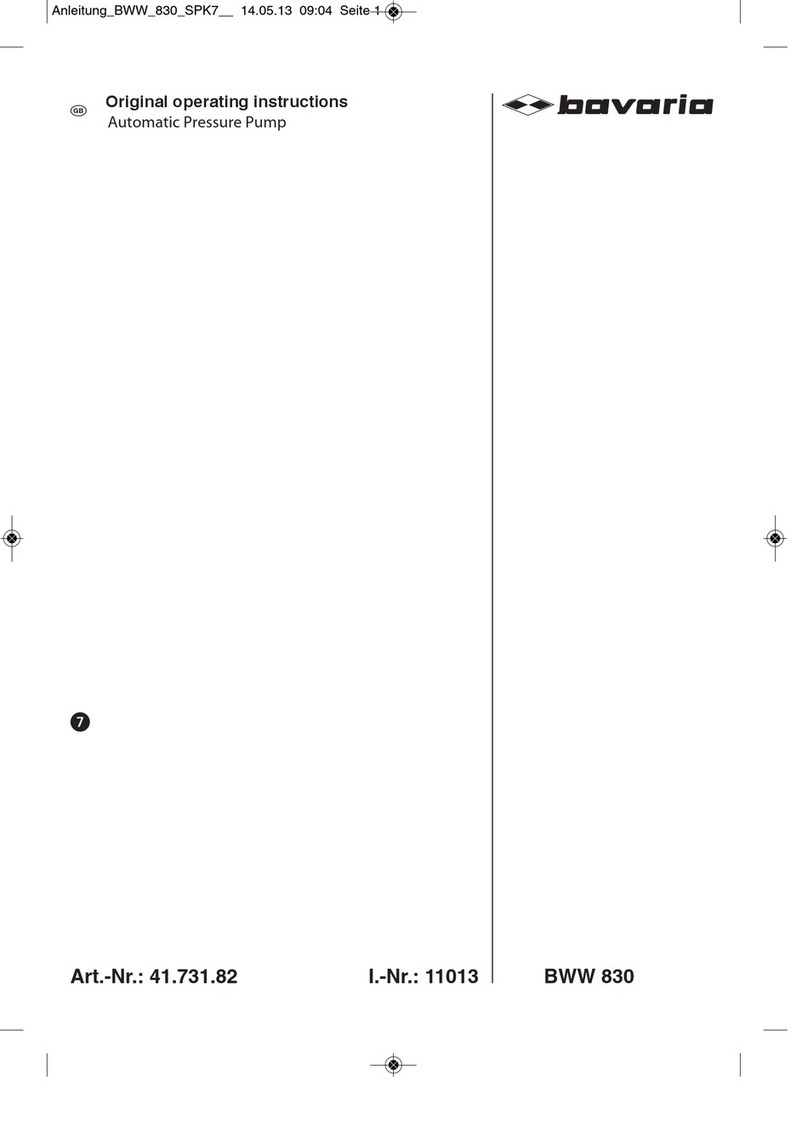
Bavaria
Bavaria BWW 830 Original operating instructions

Pfeiffer Vacuum
Pfeiffer Vacuum HENA 401 operating instructions

Macnaught
Macnaught C7 instruction manual
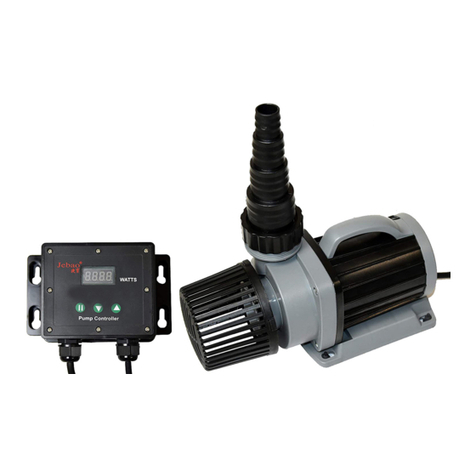
Jebao
Jebao TSP-10000 owner's manual
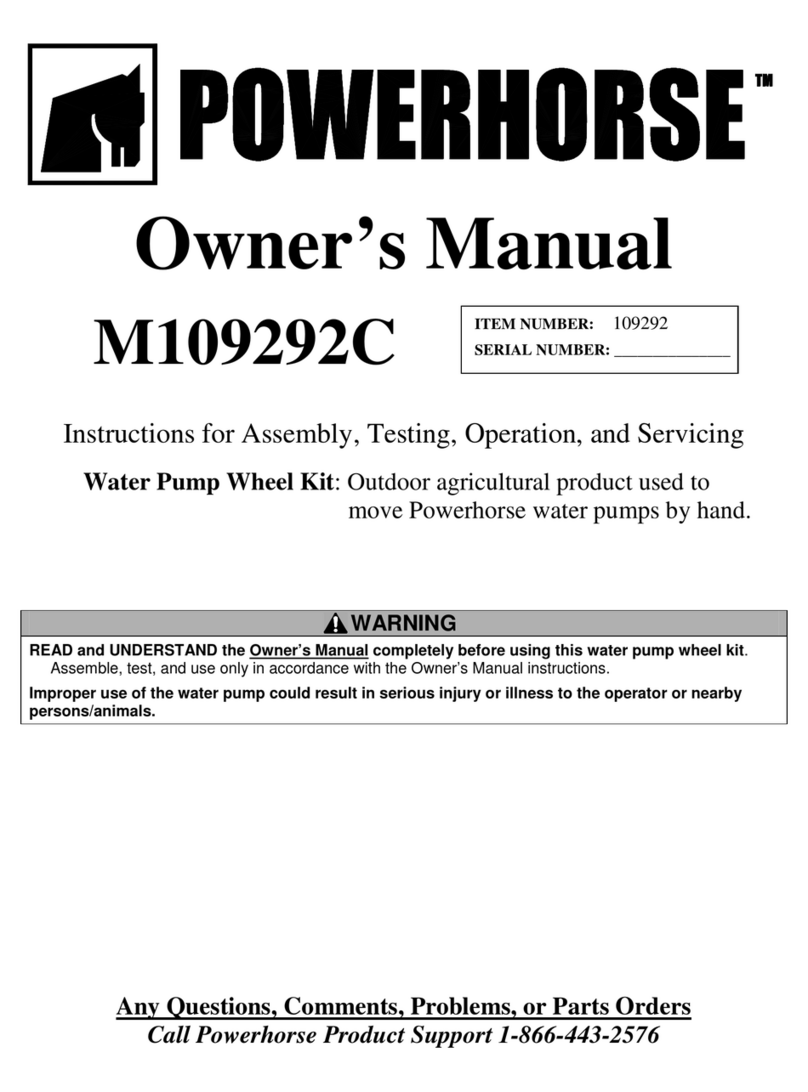
Powerhorse
Powerhorse M109292C owner's manual

Varian
Varian TriScroll 600 series manual

EBARA
EBARA 3SF Supplementary User Instructions
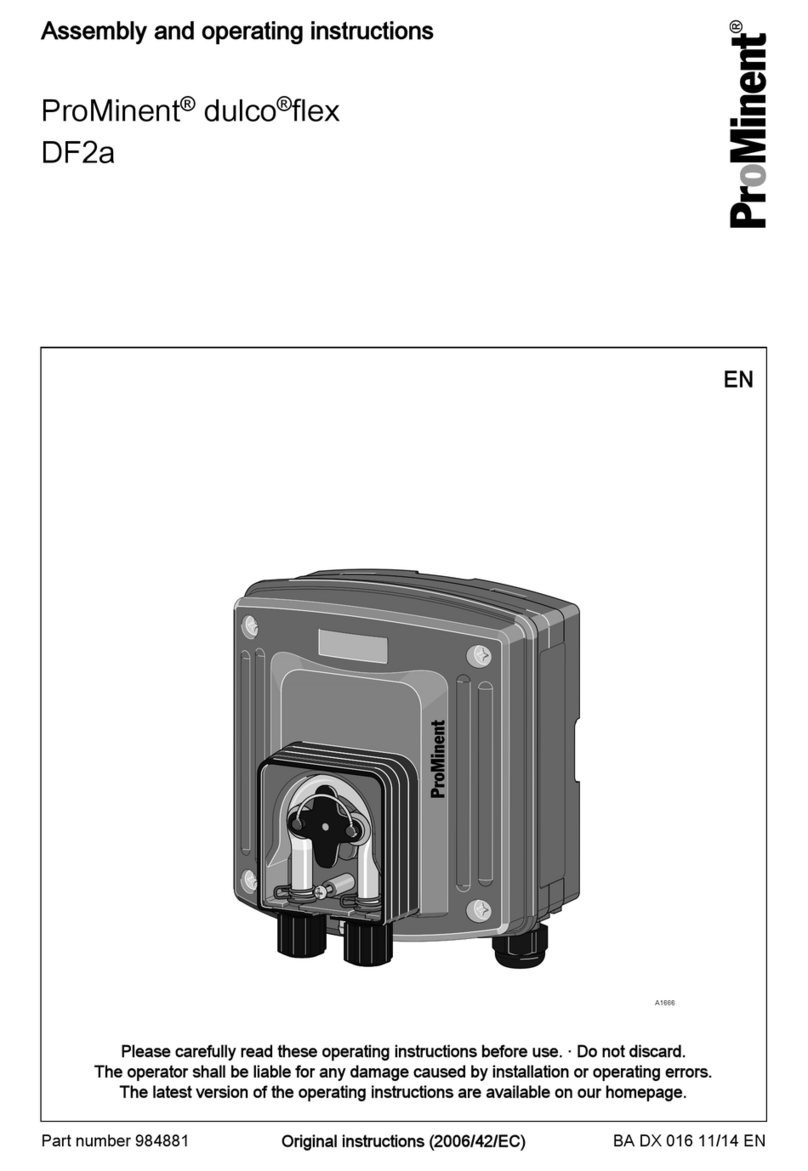
ProMinent
ProMinent Dulco Flex DF2a Assembly and operating instructions

SPERONI
SPERONI CAM APM CAM 150 operating instructions
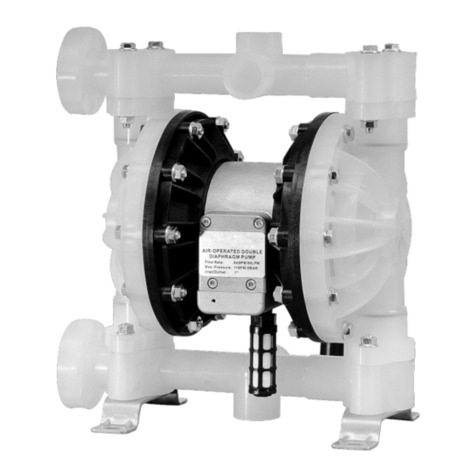
Macnaught
Macnaught DP1-FPM instruction manual
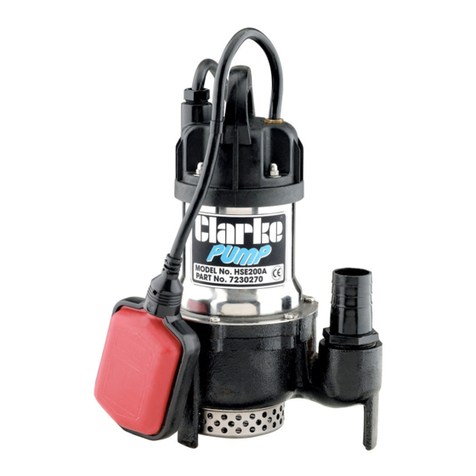
Clarke
Clarke HSE RANGE Operation & maintenance instructions

